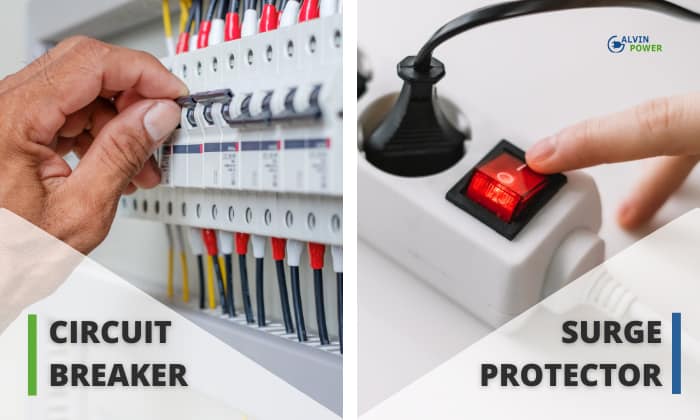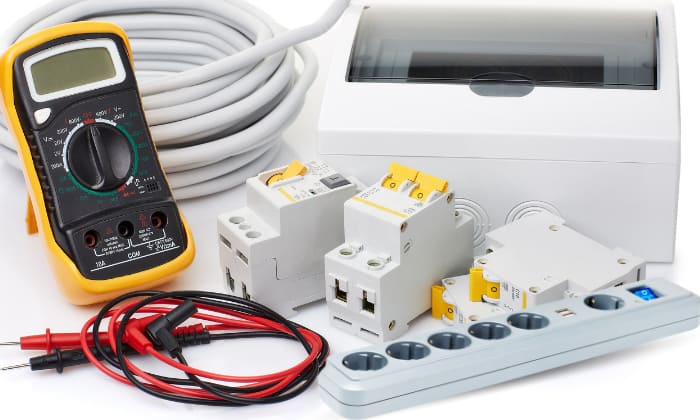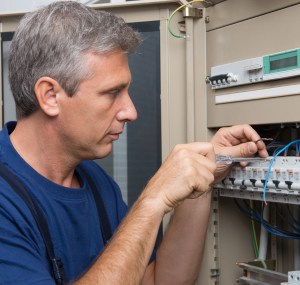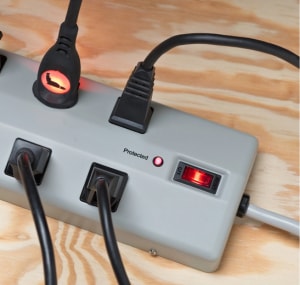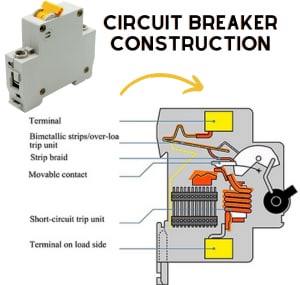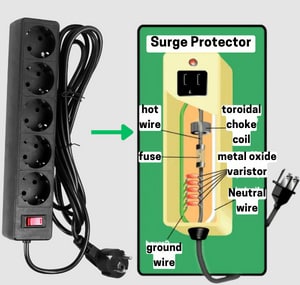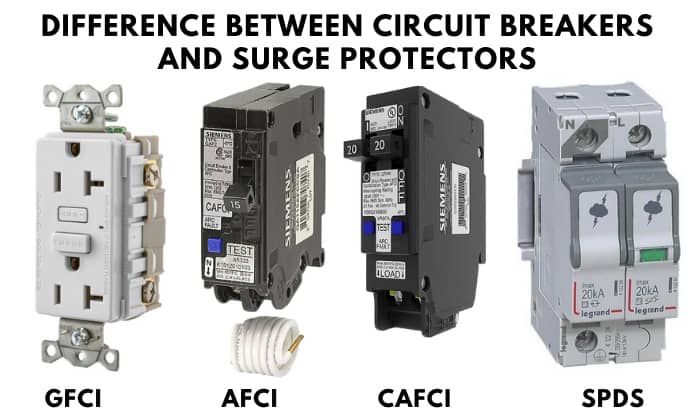The advancement of technology these past few years has introduced new devices that make our lives easier. Such devices are often reliant on electricity, which are highly susceptible to faults in the electrical line.
Fortunately, there are protectors against short circuit and power spikes: circuit breakers and surge protectors. Together, these two provide security to our home’s circuitry and the appliances connected to it.
Regardless, there are differences in how they operate – which could confuse homeowners seeking to install electrical protection devices on their property.
I wrote this article to explain the distinction between a circuit breaker vs surge protector. Read on if you want to learn more about them!
Table of Contents
What Are Circuit Breakers and Surge Protectors?
Circuit breaker
To put it simply: circuit breakers are vital safety instruments for properties with electrical circuitry. Compared to surge protectors, circuit breakers are more notable as they have been the staple of homes for a long time and are required by the National Electrical Code.
They are often located and installed within your property’s electrical panel or for fuse box. Circuit breaker protection is provided by regulating the flow of current within the lines running through the said panel.
Essentially, circuit breakers are internal switches that cut the flow of electricity once they detect faults within the circuitry, which could either cause overloads or short circuits.
By doing so, circuit breakers prevent additional damage to appliances or devices connected to faulty lines. Other electrical mishaps such as electrocution and electrical fires can be prevented and mitigated due to circuit breakers.
Surge protector
On the other hand, a surge protector is an electrical device that was constructed in order to prevent damage caused by sudden voltage spikes and power surges.
These spikes in electric activities can be caused by various external factors such as unexpected lightning strikes to electrical lines, utility maintenance, and the usage of appliances that consume large amounts of electricity.
Now, power surge breakers operate by using an instrument called metal oxide varistors (MOVs) that could divert and absorb excess electricity before it reaches your appliances and devices – preventing damage and incurring costs.
Though there is no surge protector built in circuit breaker, one can use the two devices together.
Compared to circuit breakers, which are installed for panel box; surge protectors can be found in power strips and wall outlets – they are also available as a whole house surge protector.
That being said, power strip surge protectors are the most common type as they do not require installation and can protect various appliances in an instant.
Conversely, outlet-type surge protectors are commonly found within walls. Unlike power strip protectors, they need to be wired into place and are smaller in size.
Perhaps providing the most extensive protection, a breaker panel surge protector can regulate sudden and abnormal flows of electricity throughout your home.
How Do Circuit Breakers and Surge Protectors Work?
Now that we have discussed the basic purpose of circuit breakers and surge protectors, let’s now explore how both of these work.
Circuit breaker
Now, circuit breakers are constructed with two main components: a bimetallic strip and an electromagnet.
First, the bimetallic strip consists of different metal types that are bonded together through industrial treatment. The strip is responsible for stopping the flow of electricity as it bends when it heats up under excess current, causing the breaker’s contact to split open.
The electromagnet works the same way as this component. The only difference is that it uses an electromagnetic coil to trip the circuit breaker.
After being engaged, the circuit breaker must then be manually returned to its “on” position by flipping the switch to restore the flow of electricity within the line.
Surge protector
As I have stated above, surge protectors generally work by diverting extra electricity, preventing your appliances from being damaged.
However, the exact process of how they do this is often overlooked. For this reason, let me illustrate how surge protectors work in simpler terms.
Surge protectors come with an important component called the Metal Oxide Varistor (MOV). It is made of voltage-sensitive material that can capably conduct electricity when the voltage is in a safe range.
However, it can quickly reduce electrical resistance when its safety threshold has been reached, allowing it to divert and dissipate electricity.
Particularly, when a surge or spike is registered, the MOV absorbs the excess electricity flowing through the line, ensuring the integrity and safety of your devices and appliances, protecting them from electrical damage.
Essentially, surge suppressors keep track of voltage while circuit breakers focus on amperage.
What is the Difference Between Circuit Breakers and Surge Protectors?
Aside from their basic functions, a major difference between circuit breakers and surge protectors is that the former is mandatory while the latter is optional.
Interestingly, certain types of breakers, such as GFCI, AFCI, and CAFCI units should not be used with surge protectors, since the work of SPDs often causes them to trip.
However, a stand-alone breaker (one not in the main panel) is necessary in some cases to protect against faults within the surge-diverting device. For instance, the breaker will shut off power to the surge protector and allow users to remove it for maintenance without disrupting other circuits.
This also answers the question of how does a surge protector breaker work.
Related comparisons:
Circuit Breakers vs Surge Protectors: Which is Better? Pros and Cons of Both
| Circuit Breaker | Surge Protector |
| Protects the electrical system from overloading or shorting | Protects devices and appliances from electrical damage caused by sudden surges |
| Can be reset and reused after being triggered | Can be installed at any points of electrical contact |
| Cannot regulate sudden electrical surges caused by lightning or other high voltage sources | Has a limited lifespan, must be periodically checked |
Taking all of these into consideration, determining whether you should install a surge protector vs circuit breaker in your home should be straightforward.
Frequently Asked Questions
Can you use a circuit breaker as a surge protector?
No, a circuit breaker cannot be used as a surge protector. Let me say that clearly. While circuit breakers and surge protectors can secure the integrity of your electrical system, they have distinct purposes and could not be used interchangeably.
Circuit breakers mainly secure the electrical system against current irregularities, while surge protectors are made to protect your devices and appliances from sudden voltage surges.
Can circuit breakers protect against lightning?
No. Circuit breakers cannot protect your electrical system from lightning. Electricians, engineers, and even users on Reddit state that a great way to prevent lightning from damaging your circuitry is by installing lightning rods to directly ground the high-intensity voltage.
Does my breaker box need a surge protector?
Not necessarily. The only required component to be installed in breaker boxes are circuit breakers. Regardless, surge protectors can be installed in an electrical panel in order to provide more extensive protection against power surges.
What is a circuit breaker on a power strip?
A circuit breaker that is installed on a power strip is a secured electrical safety feature that allows you to safeguard your electronics from short circuits or overloading.
Does surge protector prevent tripping circuit breaker?
No, surge protectors do not prevent a breaker from tripping. Triggering a breaker is often caused by current overloads or shorting. Meanwhile, surge protectors safeguard against sudden voltage surges.
Conclusion
To be brief, circuit breakers and surge protectors are highly relevant electrical safety equipment for your home.
Both of them serve important roles when it comes to the safety of your residence – preventing the onset of unmitigated electrical faults that could eventually lead to fire and injuries.
As always, I wish that I have expanded on circuit breaker vs surge protector in a detailed manner. If you have any questions, drop them in the question section below. Thanks for reading!

I am Edwin Jones, in charge of designing content for Galvinpower. I aspire to use my experiences in marketing to create reliable and necessary information to help our readers. It has been fun to work with Andrew and apply his incredible knowledge to our content.

